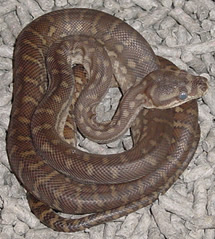Central Australian python
| Central Australian python | ||||||||||||
|---|---|---|---|---|---|---|---|---|---|---|---|---|

Central Australian python ( Morelia bredli ) |
||||||||||||
| Systematics | ||||||||||||
|
||||||||||||
| Scientific name | ||||||||||||
| Morelia bredli | ||||||||||||
| ( Gow , 1981) |
The Central Australian Python , also inland carpet python or Bredl's python ( Morelia bredli ) is a type of diamond python ( Morelia ) from the family of pythons (Pythonidae). The species was named after the Australian herpetologist and snake park owner Joe Bredl . It is not recognized by all authors and is partly regarded as a population of the diamond python ( Morelia spilota ).
features
The Central Australian Python reaches an average length of 150 to 200 cm, with a maximum length of 265 cm. The basic color is very variable and ranges from brown to strong red to yellowish. There are lighter, yellowish spots and stripes on it, which are usually darkly edged. The head stands out clearly from the long neck. The ventral side is white to cream in color.
The two internasalia , either touching or separated by a series of small scales, are bordered by a pair of prefrontal shields, separated by a small shield . The rest of the top of the head is covered with numerous small scales. The large eye is surrounded by a semicircle of eight to twelve scales, with three to five supraocular shields above it . Thermal pits are located on the rostral shield , on the front two to three of the 13 to 15 supralabial shields and on about five of the 19 to 21 infralabial shields under the eye. The middle of the trunk has 52 to 54 rows of smooth scales, the belly 280 to 310 ventral and 80 to 120 mostly divided subcaudal shields and an undivided anal shield .
Distribution and way of life
The species is endemic to the southern mountainous landscapes of the Northern Territory . The animals spend the day in crevices, caves or other hiding spots and hunt birds and small mammals at night. The mating takes place from August to September, the females lay up to 40 eggs.
swell
- Ludwig Trutnau : Non-poisonous snakes, part 1 . 4th edition. Eugen Ulmer GmbH & Co., Stuttgart 2002, ISBN 3-8001-3223-0 .
- ^ AG Kluge: Aspidites and the phylogeny of the pythonine snakes . In: Records of the Australian Museum . tape 19 , 1993, pp. 1-77 (English).
Web links
- Bredls Python at www.reptilienland.com
- Morelia bredli in The Reptile Database